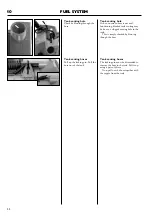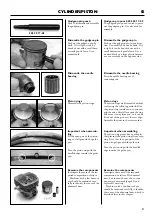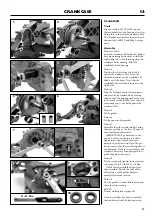
The simplest method to lift the cylinder is to allow the carburettor
with the inlet units and muffler to remain in place on the cylinder.
Dismantle according to this method as follows:
– Dismantle the three screws on the inlet units.
– Dismantle the lower screw on the muffler.
– Dismantle the four screws at the base of the cylinder.
New, run-in engine approximately 9 bar
Rectify below 7 bar
CYLINDER/PISTON
13
29
Compression test
The test indicates leakage from
the combustion chamber.
Close the decompression
valve or fit the sealing plug
503 55 22-01.
Cylinder
Dismantling
The service actions necessary determine the most appropriate method.
Splitting the machine at the vibration dampening element provides the best
view and accessibility. However, the cylinder can be lifted without this
splitting procedure.
It may be appropriate to secure the engine body in a vice to facilitate work.
Use soft jaw guards!
Compression test
The compression test indicates leakage
from the combustion chamber. If the
machine lacks engine power and is diffi-
cult to start this may be due to poor
compression.
Close the decompression valve or fit
the sealing plug 503 55 22-01 to eliminate
the decompression valve as the source of
the fault.
503 55 22-01
531 03 16-86
Compression tester
The compression test is performed using
the measurement instrument 531 03 16-86,
which is connected to the spark plug
hole. The valve below the gauge evacuates
the pressure.
Compression tester
Connect the compression tester
in the spark plug hole.
Compression test
– Run the engine warm for a few minutes.
– Unscrew the spark plug and con nect
the instrument.
– Make 5–6 attempts to start and read
the pressure on the gauge. Evacuate the
pressure and repeat the procedure a few
times. Note the average value for the
tests.
The average value for a new and run-in
engine is approximately 9 bar (130 psi).
Values less than 7 bar (100 psi) indicate
faults with on the cylinder, piston or
piston rings.
Compression test
– Run the engine warm.
– Connect the instrument.
– Make 5–6 attempts to start and
read the pressure. Evacuate the
pressure and repeat the procedure
a few times. Note the average
value for the tests.
Values less than 7 bar (100 psi)
indicate faults with on the cylin-
der, piston or piston rings.
















































